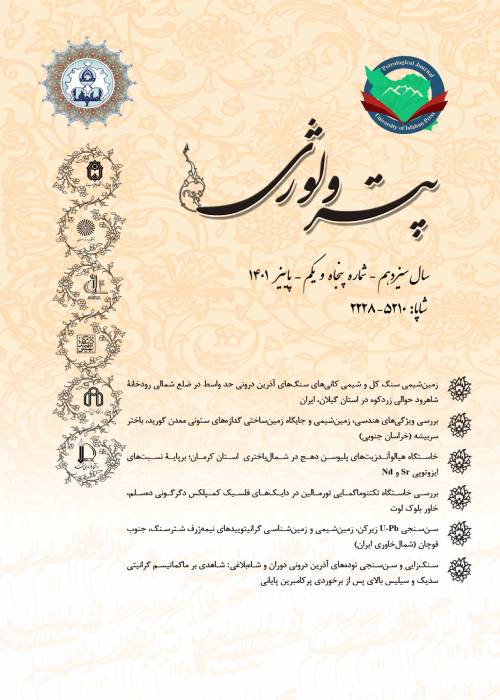Geochemistry and petrogenesis of granitoid rocks in the Tarom-Hashtjin metallogenic province, western Alborz
The Cenozoic magmatism is mainly concentrated in the Alborz magmatic arc, Urumieh-Dokhtar magmatic arc, Central and Eastern Iran. The Western Alborz magmatic arc known as Alborz-Azerbaijan is hosted numerous porphyry-epithermal deposits. It is divided into Ahar-Arasbaran in the north and Tarom-Hashtjin metallogenic province in the south. The Tarom-Hashtjin metallogenic province is associated with several epithermal mineral systems (Ghasemi Siani and Lentz, 2022) related to Cenozoic magmatism. It consists mainly of intrusive, subvolcanic rocks, as well as volcanic-sedimentary complexes with acidic to intermediate composition. These rocks with calc-alkaline to shoshonitic nature, are predominantly granite, granodiorite, basalt, andesite, dacite, rhyodacite, rhyolite, and related tuffs. Th main goal of the present paper is to review the available data combined with our new data on the granitoids widespread in the area. An attempt is made to present the lithological, geochemical, and geo-structural features of the magma generated in Tarom-Hashtjin metallogenic province.
Regional Geology:
The Tarom-Hashtjin metallogenic province is limited by the Tabriz-Soltaniyeh (Northwestern part), Soltanieh-Takestan (Southeastern part), and Astara faults (Western part). Volcanic-pyroclastic rocks have been widely invaded by the Upper Eocene intrusive bodies (including Zaker, Marvarid, Koh-e-Tabar, Takestan, Zanjan, Tarom, Rudbar-Ahar, Vermarziar, and Goljin bodies). The epithermal deposits are classified as low sulfidation (LS), intermediate sulfidation (IS), and high sulfidation (HS).
Whole rock and isotopic geochemical data obtained from 176 samples of granitoid rocks related to 17 deposits (including 4 epithermal deposits of low sulfidation (LS), 5 epithermal deposits of intermediate sulfidation (IS), 4 epithermal deposits of high sulfidation) (HS) and 4 magmatic iron oxide- apatite deposits (IOA)). The data was compiled using Microsoft Excel (Appendix 1) and contains major oxides, rare earth elements and isotopic data, rock type, sources, and associated epithermal deposits. The samples of hydrothermal altered granitoid rocks with LOI greater than 2 percent by weight were excluded from the data set. Also, Sr-Nd isotopic compositions for 33 whole rock samples and Pb isotopic compositions for 24 granitoid samples are presented in Appendix 2.
Whole rocks chemistry:
Geochemistry of major elements: The amounts of some oxides including MgO, CaO, FeO, TiO2, and Al2O3 display negative while the K2O content shows a positive correlation with increasing SiO2. The abundance of incompatible elements (i.e. Rb, Ba, Th, and Zr) increases slightly to moderately with increasing silica content. The amounts of P and Sr significantly decrease with increasing silica content. These granitoids are enriched in lithophile elements (LILE)(i.e. K, Rb, Th, U, Nd) and depleted in high field strength elements (HFSE) (i.e. Ta, Nb, Ti,) indicating the occurrence of magmatism associated with subduction and the characteristic of all magmas subjected to crustal contamination in subduction zones (Chappell and White, 1992; Wilson, 2007). Also, the investigated rocks are enriched in LREEs and depleted in HREEs (LREE/HREE = 1.14-10.34), a remarkable feature of magmas related to subduction zones (Wilson, 2007). The (La/Yb)N ratio ranges from 3.25 to 14.70 (ave.7.53). Isotope geochemistry: The studied granitoids are located in the ranges of magmas related to the subduction zone. These magmas are periodically contaminated by crustal materials. Most of the granitoid samples are placed within the depleted and enriched mantle array (Zindler and Hart, 1986).
The rocks under study associated with epithermal deposits in the Tarom-Hashtjin metallogenic province consist mainly of monzonitic, monzodioritic, quartz monzonitic, and granite belonging to high calc-alkaline to shoshonitic I type and metaluminous magmatism. They are characterized by Sr/Y (3.6 to 39.11), La/Yb (4.53 to 20.50) and high K2O values (with an average of 4.40 wt.%), consistent with calc-alkaline mantle melt contaminated by crustal materials (Chappell and White, 1992). Metaluminous and high calc-alkaline to shoshonitic igneous rocks are originated by partial melting of enriched lithospheric mantle metasomatized by fluids from the subducting slab. These granitoids also have Th values (average 15.17 g/t) higher than that of the rocks derived from primary mantle melt. Fluids and melts from the subducting oceanic crust metasomatized the mantle wedge above them causing a positive LILE and a negative HFSE anomalies. Overall, the Tarom-Hashtjin metallogenic province is part of a back-arc extensional system arc behind the main Urumieh-Dokhtar main arc. Considering this, it seems that the extensional tectonic setting in the Lower to Middle Eocene was accompanied by convergence movements and was followed until the end of the Middle Eocene and Upper Eocene. This phase of extension occurred during the Eocene associated with slab rollback. The aforementioned tectonic movements can be associated with the processes of separation of the subducting plate or convective thinning of the lithosphere, causing the uplift of the asthenosphere and temperature disturbance in the metasomatism lithospheric mantle wedge. This disturbance gave rise to partial melting of the subducting slab and the lithospheric mantle wedge producing the primary potassic magma of the granitoid rocks under study. It suggests that primary source magmas were generated by partial melting of the mantle-wedge and were subsequently affected by both fractional crystallization and crustal assimilation during their magmatic evolution during Eocene magmas (37 to 42 Ma) in a back-arc basin.
- حق عضویت دریافتی صرف حمایت از نشریات عضو و نگهداری، تکمیل و توسعه مگیران میشود.
- پرداخت حق اشتراک و دانلود مقالات اجازه بازنشر آن در سایر رسانههای چاپی و دیجیتال را به کاربر نمیدهد.



